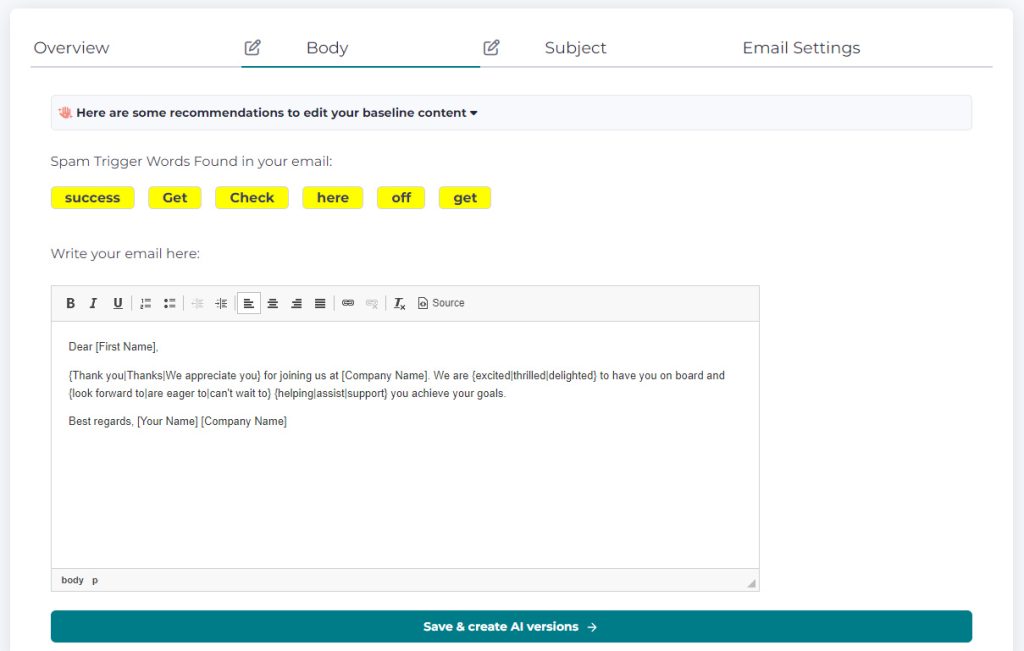Spintax is a game changer for email marketers, making it easy to create varied and engaging content.
By using spintax, you can efficiently produce multiple variations of your emails, increasing personalisation and improving your chances of resonating with different audience segments.
In this article, we’ll take you through the basics of spintax: what it is, why you should use it, how it works and when it’s best to avoid it. Dive in to learn more and improve your email marketing strategy.
TABLE OF CONTENTS
– What is Spintax?
– Why Use Spintax?
– How Spintax works
– When to avoid Spintax
– Conclusions
What is Spintax?
Spintax, short for “spinning syntax,” is a specialized formatting technique used to generate multiple variations of text content. It is commonly used in search engine optimisation (SEO), marketing and content creation.
The main idea behind spintax is to create different versions of words, phrases or sentences by using a specific syntax within spinning ‘brackets’, allowing the programmatic generation of multiple permutations of content.
Key components of Spintax
- Spinning brackets: These are denoted by { } braces and define the start and end of a spinning section.
- Pipes: The | pipe symbol separates alternate versions within a spin.
- Plain text: This is the static text that remains unchanged between different versions.

Why use Spintax?
Spintax offers several advantages for email marketers:
- Efficiency and time savings: Spintax enables marketers to quickly generate multiple variations of email content. This automation reduces the time and effort required to create unique messages, allowing marketers to focus on other important tasks.
- Avoid duplicate content penalties: Search engines and email providers penalise duplicate content, which can reduce visibility and deliverability. Spintax helps create unique variations of content, avoiding these penalties and ensuring better performance.
- Improved personalisation: Personalised emails have higher engagement rates. Spintax enables the creation of tailored messages for different audience segments, improving relevance and resonance with recipients.
- Increased engagement: By introducing subtle variations in content, Spintax can keep audiences interested and engaged. This leads to higher open rates, click-through rates and overall better campaign performance.
- Scalability: For large email campaigns, especially those targeting diverse audiences, spintax offers scalability. Marketers can efficiently manage and deploy large campaigns without sacrificing content quality.
- Improved SEO and deliverability: When used strategically, spintax can help insert targeted keywords and phrases, increasing the SEO value of content. In addition, unique variations of content are less likely to be flagged as spam, improving email deliverability.
How Spintax works
Spintax operates through a two-step process: generating the spin syntax and processing the spun variations. These steps enable the creation of multiple content variations from a single template.
1. Spin syntax generation
Creating effective spin syntax involves the following best practices:
- Identify keywords or phrases to spin: Determine which parts of the content you want to vary. Focus on key phrases to avoid over-complication.
- Maintain tone and style: Ensure that the spun variations are consistent with the overall style and voice of the original content.
- Ensure coherence: Review spun versions to ensure they make sense and are grammatically correct.
- Limit the amount of spinning: Excessive spinning can make content look unnatural and trigger spam filters.
- Use spinning tools: Specialised tools can help generate spin syntax quickly and accurately.
- Creating high-quality spin syntax takes practice: When done correctly, it allows for the creation of almost endless content variations with minimal effort.
2. Processing spun variations
After crafting the spin syntax, specialized software generates the possible content permutations. There are two primary methods for this:
a) Recursive method
This approach uses a recursive algorithm to systematically explore every possible combination of the spin syntax.
The key advantage is comprehensive coverage, ensuring all permutations are generated. However, it can be slow and resource-intensive, especially for large sets of spin syntax.
b) Random method
This method employs a random or probabilistic algorithm to select permutations. Its main advantage is speed, making it significantly faster than the recursive method. The downside is that it may not cover all possible combinations exhaustively.
Each method has its merits. The recursive method guarantees thoroughness, generating every potential variation, while the random method excels in speed, ideal for scenarios with time or resource constraints.
Software Efficiency
Most spinning software uses efficient algorithms to quickly generate hundreds or thousands of spun variations with minimal computing resources.
This makes the process of content creation scalable and efficient, allowing for extensive use in SEO, marketing, and content creation without significant time investment.
When to avoid Spintax
Although spintax can be extremely powerful, it is not suitable for every type of content. Here are some scenarios where it’s best to avoid using spintax:
- Need for precision: Step-by-step tutorials require a precise and logical flow. Excessive spinning can disrupt this flow, making the tutorial confusing and less effective.
- Tight reasoning: Essays, arguments and dissertations rely on tight reasoning and coherence. Spinning can undermine the logical structure and weaken the argument.
- Specific phrasing: Jokes, stories and humorous content depend on specific phrasing for their impact. Using spintax can ruin the punch line or change the intended humour.
- Consistent voice: Reviews and unique opinions need a consistent voice to be credible and effective. Randomly spun variations can appear disjointed and disingenuous.
- Precision of terminology: Legal documents and communications require precise legal terminology. Spinning this content can lead to inaccuracies and serious consequences.
Conclusions
Apply the insights from this guide to refine your email campaigns and achieve better results. Keep experimenting and learning to stay ahead in the competitive landscape of email marketing.
Ready to take your email marketing to the next level? Try our free demo today and discover how Outbound Rocks can help you optimize your sales funnel and connect with your ideal prospects.
